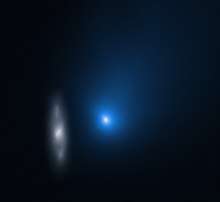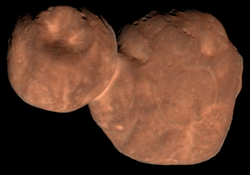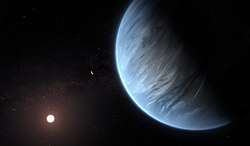2I/Borisov
2I/Borisov, originally designated C/2019 Q4 (Borisov),[8] is the first observed interstellar comet and the second observed interstellar interloper after ʻOumuamua.[9][10] 2I/Borisov has a heliocentric orbital eccentricity of 3.36 and is not bound to the Sun.[11] The comet passed through the ecliptic of the Solar System at the end of October 2019, and made its closest approach to the Sun at just over 2 AU on 8 December 2019.[3][12] In November 2019, astronomers from Yale University said that the comet (including coma and tail), was 14 times the size of Earth, and stated, “It’s humbling to realize how small Earth is next to this visitor from another solar system.”[13] In the middle of March, 2020, the comet was observed to fragment;[14] and later, in April, even more evidence of fragmentation was reported.[15][16][17]
.png) Borisov in October 2019[lower-alpha 1] | |
| Discovery | |
|---|---|
| Discovered by | Gennadiy Borisov |
| Discovery date | 30 August 2019 Earliest precovery: 13 December 2018 |
| Orbital characteristics A | |
| Epoch | 5 January 2020[3] |
| Observation arc | 389 days |
| Number of observations | 1191 |
| Perihelion | 2.00662±0.00002 au |
| Semi-major axis | −0.85132±0.00007 au[lower-alpha 2] |
| Eccentricity | 3.3570±0.0002 (JPL) 3.357 (MPC)[4] |
| Inclination | 44.0535°±0.0001° |
| Node | 308.1500°±0.0003° |
| Argument of periapsis | 209.1244°±0.0004° |
| Earth MOID | 1.09302 au |
| Jupiter MOID | 2.388 au |
| Dimensions | ≤0.5km[5](for an albedo of 0.04) ≤0.4km[6] |
| Last perihelion | 8 December 2019[3][4][7] |
Nomenclature
The comet is formally called "2I/Borisov" by the International Astronomical Union (IAU), with "2I" or "2I/2019 Q4" being its designation and "Borisov" being its name, but is sometimes referred to as "Comet Borisov", especially in the popular press.[lower-alpha 3] As the second observed interstellar interloper after 1I/ʻOumuamua, it was given the "2I" designation, where "I" stands for interstellar.[18][8] The name Borisov follows the tradition of naming comets after their discoverers. Before final designation as 2I/Borisov, the object was referred to by other names:
- Early orbit solutions suggested that the comet could be a near-Earth object and was thus listed on IAU's Minor Planet Center's (MPC) Near-Earth Object Confirmation Page (NEOCP) as gb00234.[19]
- Further refinements after thirteen days of observation made clear the object was a hyperbolic comet, and it was given the designation C/2019 Q4 (Borisov) by the Minor Planet Center on 11 September 2019.[20] Astronomers such as Davide Farnocchia, Bill Gray, and David Tholen were already confident that the comet was interstellar.[20]
- On 24 September 2019 the IAU announced that the Working Group for Small Body Nomenclature kept the name Borisov giving the comet the interstellar designation of 2I/Borisov, formally announcing the comet was indeed interstellar.[18][8]
Characteristics
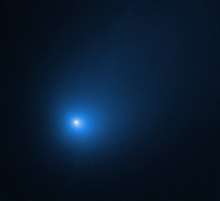
Unlike ʻOumuamua, which had an asteroidal appearance, 2I/Borisov's nucleus is surrounded by a coma, a cloud of dust and gas.[21]
Size and shape
Early estimates of nucleus 2I/Borisov diameter have ranged from 1.4 to 16 km.[24][25] 2I/Borisov has, unlike Solar System comets, noticeably shrunk during Solar System flyby, losing at least 0.4% of its mass before perihelion.[6] Also, the amplitude of non-gravitational acceleration place an upper limit of 0.4 km on nucleus size, consistent with a previous Hubble Space Telescope upper limit of 0.5 km.[5] The comet did not come much closer to Earth than 300 million km, which prevents using radar to directly determine its size and shape. This could be done using the occultation of a star by 2I/Borisov but an occultation would be difficult to predict, requiring a precise determination of its orbit, and the detection would necessitate a network of small telescopes.[26]
Rotation
A study using observations from Hubble could not find a variation in the light curve. According to this study the rotational period must be larger than 10 hours.[27] A study with CSA's NEOSSat found a period of 13.2 ± 0.2 day, which is unlikely the nuclear spin.[28]
Chemical makeup and nucleus structure
Dave Jewitt and Jane Luu estimate from the size of its coma the comet is producing 2 kg/s of dust and is losing 60 kg/s of water. They extrapolate that it became active in June 2019 when it was between 4 and 5 au from the Sun.[5] A search of image archives found precovery observations of 2I/Borisov as early as 13 December 2018, but not on 21 November 2018, indicating it became active between these dates.[29]
2I/Borisov's composition appears uncommon yet not unseen in Solar System comets, being relatively depleted in water and diatomic carbon (C2) , but enriched in carbon monoxide and amines (NH2).[30] Molar ratio of carbon monoxide to water in 2I/Borisov tail is 35%-105%, resembling unusual blue-tailed comet C/2016 R2 while average for solar system comets is 4%.[31]
Trajectory
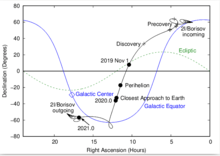
| Object | Velocity |
|---|---|
| 1I/2017 U1 (ʻOumuamua) | 26.33 km/s 5.55 au/yr[32] |
| 2I/2019 Q4 (Borisov) | 32.2 km/s 6.79 au/yr[33] |
As seen from Earth, the comet was in the northern sky from September until mid-November. It crossed the ecliptic plane on 26 October near the star Regulus[34], and the celestial equator on 13 November 2019, entering the southern sky. On 8 December 2019, the comet reached perihelion (closest approach to the Sun)[3] and near the inner edge of the asteroid belt.[lower-alpha 5] In late December, it made its closest approach to Earth,[35][12] 1.9 au, and had a solar elongation of about 80°.[7] Due to its 44° orbital inclination, 2I/Borisov does not make any notable close approaches to the planets.[3] 2I/Borisov entered the Solar System from the direction of Cassiopeia near the border with Perseus. This direction indicates that it originates from the galactic plane, rather than from the galactic halo.[33][36] It will leave the Solar System in the direction of Telescopium.[33][36] In interstellar space, 2I/Borisov takes roughly 9000 years to travel a light-year relative to the Sun.[lower-alpha 6]
2I/Borisov's trajectory is extremely hyperbolic, having an orbital eccentricity of 3.36.[3][4] This is much higher than the 300+ known weakly hyperbolic comets, with heliocentric eccentricities just over 1, and even ʻOumuamua with an eccentricity of 1.2.[37][lower-alpha 7] 2I/Borisov also has a hyperbolic excess velocity () of 32 km/s, much higher than what could be explained by perturbations, which could produce velocities when approaching an infinite distance from the Sun of less than a few km/s.[38] These two parameters are important indicators of 2I/Borisov's interstellar origin.[33][39] For comparison, the Voyager 1 spacecraft, which is leaving the Solar System, is traveling at 16.9 km/s (3.57 au/yr).[40] 2I/Borisov has a much larger eccentricity than ʻOumuamua due to its higher excess velocity and its significantly higher perihelion distance. At this larger distance, the Sun's gravity is less able to alter its path as it passes through the Solar System.[33]



Observation
Discovery
| # of observations |
Observation arc (hours) |
Eccentricity range |
|---|---|---|
| 81 | 225 | 0.9–1.6 |
| 99 | 272 | 2.0–4.2 |
| 127 | 289 | 2.8–4.7 |
| 142 | 298 | 2.8–4.5 |
| 151 | 302 | 2.9–4.5 |
The comet was discovered on 30 August 2019 by amateur astronomer Gennadiy Borisov at his personal observatory MARGO in Nauchnyy, Crimea, using a 0.65-meter telescope he designed and built himself.[42] The discovery has been compared to the discovery of Pluto by Clyde Tombaugh.[43] Tombaugh was also an amateur astronomer who was building his own telescopes, although he discovered Pluto using Lowell Observatory's astrograph. At discovery, it was inbound 3 au from the Sun, 3.7 au from Earth, and had a solar elongation of 38°.[44] Borisov described his discovery thus:[45]
I observed it on August 29, but it was August 30 Greenwich Time.[lower-alpha 8] I saw a moving object in the frame, it moved in a direction that was slightly different from that of main asteroids.[lower-alpha 9] I measured its coordinates and consulted the Minor Planet Center database. Turned out, it was a new object. Then I measured the near-Earth object rating,[lower-alpha 10] it is calculated from various parameters, and it turned out to be 100% – in other words, dangerous. In such cases I must immediately post the parameters to the world webpage for confirmation of dangerous asteroids.[lower-alpha 11] I posted it and wrote that the object was diffuse and that it was not an asteroid, but a comet.
2I/Borisov's interstellar origin required a couple of weeks to confirm. Early orbital solutions based on initial observations included the possibility that the comet could be a near-Earth object 1.4 au from the Sun in an elliptical orbit with an orbital period of less than 1 year.[19] Later using 151 observations over 12 days, NASA Jet Propulsion Laboratory's Scout gave an eccentricity range of 2.9–4.5.[46] But with an observation arc of only 12 days, there was still some doubt that it was interstellar because the observations were at a low solar elongation, which could introduce biases in the data such as differential refraction. Using large non-gravitational forces on the highly eccentric orbit, a solution could be generated with an eccentricity of about 1, an Earth minimum orbit intersection distance (MOID) of 0.34 au (51 million km), and a perihelion at 0.90 au around 30 December 2019.[47] However, based on available observations, the orbit could only be parabolic if non-gravitational forces (thrust due to outgassing) affected its orbit more than any previous comets.[48] Eventually with more observations the orbit converged to the hyperbolic solution that indicated an interstellar origin and non-gravitational forces could not explain the motion.[20]
Observation tools
Unless the comet fades or disintegrates unexpectedly, it should be observable until at least September 2020.[20] Observation of 2I/Borisov is aided by the fact that the comet was detected while inbound towards the Solar System. ʻOumuamua had been discovered as it was leaving the system, and thus could only be observed for 80 days before it was out of range. Because of its closest approach occurring near traditional year-end holidays, and the capability to have extended observations, some astronomers have called 2I/Borisov a "Christmas comet".[11][49] Observations using the Hubble Space Telescope began on 12 October, when the comet moved far enough from the Sun to be safely observed by the telescope.[50] Hubble is less affected by the confounding effects of the coma than ground-based telescopes, which will allow it to study the rotational light curve of 2I/Borisov's nucleus. This should facilitate an estimate of its size and shape. The observations will serve as a baseline for possible further observations, as the comet approaches perihelion and then leaves the Solar System.
Comet chemistry
A preliminary (low-resolution) visible spectrum of 2I/Borisov was similar to typical Oort Cloud comets.[51][52] Its color indexes also resemble the Solar System's long period comets.[5] Emissions at 388 nm indicated the presence of cyanide (formula CN), which is typically the first detected in Solar System comets including comet Halley[53]. This was the first detection of gas emissions from an interstellar object.[54] The non-detection of diatomic carbon has also been reported in October 2019, with the ratio C2 to CN being less than either 0.095[55] or 0.3.[56] The diatomic carbon was positively detected in November 2019, with measured C2 to CN ratio of 0.2±0.1.[57] This resembles a carbon-chain depleted group of comets. These are either Jupiter family comets,[55] or rare blue-colored carbon monoxide comets exemplified by C/2016 R2 comet.[58] By the end of November 2019, C2 production have dramatically increased, and C2 to CN ratio have reached 0.61, along with appearance of bright amine (NH2) bands.[59] Atomic oxygen has also been detected, from this observers estimated an outgassing of water at a rate similar to Solar System comets.[60][61] Initially, neither water nor OH lines were directly detected[62] in September 2019. First unambiguous detection of OH lines was done 1 November 2019, and OH production peaked in early December 2019.[63]
Suspected nucleus fragmentation
The comet did come within about 2 au of the Sun, a distance at which many small comets have been found to disintegrate. The probability that a comet disintegrates strongly depends on the size of its nucleus; Guzik et al. estimated a probability of 10% that this will happen to 2I/Borisov.[64] Jewitt and Luu compared 2I/Borisov to C/2019 J2, another comet of similar size that disintegrated in May 2019 at a distance of 1.9 au from the Sun.[65][5] In the event that the nucleus disintegrates, as is sometimes seen with small comets, Hubble can be used to study the evolution of the disintegration process.[66][5]
The severe outburst in February-March 2020, led to suspected "ongoing nucleus fragmentation" from the comet by March 12.[14] Indeed, images from the Hubble Space Telescope taken on March 30, 2020 show a non-stellar core indicating that Comet 2I/Borisov has ejected sunward a large fragment.[15][16][67] The ejection is estimated to have begun around March 7,[68] and may have occurred during one of the outbursts that occurred near that time.[69]. The ejected fragment appeared to have vanished by 6 April 2020.[70]
A followup study, reported on 6 April 2020, observed only a single object, and noted that the fragment component had now disappeared.[70][17] Later analysis of the event showed the ejected dust and fragments have a combined mass of about 0.1% of total mass of nucleus, making event a large outburst rather than fragmentation.[71]
Exploration
The higher hyperbolic excess velocity of 2I/Borisov of 32 km/s makes it even harder to reach for a spacecraft than 1I/'Oumuamua (26 km/s). According to a team of the Initiative for Interstellar Studies, a two-ton spacecraft could theoretically have been sent in July 2018 to intercept 2I/Borisov using a Falcon Heavy-class launcher, but only if the object had been discovered much earlier than it was. Launches after the actual discovery date would require a significantly larger launcher such as the Space Launch System (SLS) and Oberth manoeuvres near Jupiter and near the Sun. By September 2019, even an SLS-class launcher would only be able to deliver a 3 kg (6.6 lb) payload (such as a CubeSat) into a trajectory that could intercept 2I/Borisov in 2045 at a relative speed of 34 km/s.[72] According to congressional testimony, NASA may need at least five years of preparation to launch such an intercepting mission.[73]
See also
- C/1980 E1 (Bowell) – the most eccentric comet known in the Solar System with an eccentricity of 1.057
- List of Solar System objects by greatest aphelion
- Blue (carbon monoxide rich) comets
Notes
- A photograph of Borisov's dust trail taken on 12 October 2019 with the UVIS F350LP channel of Wide Field Camera 3 aboard the Hubble Space Telescope.[1][2] At the time of this photograph, Borisov was 418,000,000 kilometres (260,000,000 mi) from Earth, similar to the average distance of the asteroid Ceres from the Sun, and traveling at a velocity of 177,000 kilometres per hour (110,000 mph).[2]
- Objects with eccentricities greater than 1 will have a negative semimajor axis, giving them a positive orbital energy – the smaller the perihelion distance, and the larger above 1 the eccentricity is, the closer to 0 the semimajor axis value will be.
- This is the eighth comet discovered by Gennadiy Borisov, and thus the ambiguous term "Comet Borisov" is not formally used here.
- For objects gravitationally bound to the Sun, velocities when approaching the equivalent of an infinite distance from the Sun should be less than a few kilometres per second. At its furthest distance from the Sun, Halley's comet moves ≈1 km/s with respect to the Sun.
- 2I/Borisov will come to perihelion outside the orbit of Mars at a distance of 2.01 au, which is just inside the 4:1 Kirkwood gap located at 2.06 au.
- 299792.458 km/s / 32.2 km/s = 9310 times slower than light.
- A comet with a parabolic trajectory (with an eccentricity of 1) would leave the Solar System in the direction it entered, having had its path altered by 180°. 2I/Borisov, with its higher eccentricity, has a more open trajectory and will have its path altered by only 34° as it passes through the Solar System.
- This is obviously a mistake: Crimea is 3 hours ahead of Greenwich, so it was August 30 in Crimea when Borisov first observed the comet.
- Of the 850,000 objects known to orbit the Sun, 756,000 (89%) are main-belt asteroids.
- NEO Rating for calculating the probability that a new object is a near-Earth candidate.
- The NEO Confirmation Page for confirming near-Earth objects and potentially hazardous objects.
References
-
National Aeronautics and Space Administration; European Space Agency; Jewitt, David (16 October 2019). "Comet 2I/Borisov Compass Image". Hubblesite. Archived from the original on 17 October 2019. Retrieved 17 October 2019.
C/2019 Q4 (Borisov); HST WFC3/UVIS F350LP; Oct. 12, 2019
-
National Aeronautics and Space Administration; European Space Agency; Jewitt, David (16 October 2019). "Hubble Observes First Confirmed Interstellar Comet". Hubblesite. Archived from the original on 17 October 2019. Retrieved 17 October 2019.
Hubble took a series of snapshots as the comet streaked along at 110,000 miles per hour. [...] The comet was 260 million miles from Earth when Hubble took the photo. [...] This Hubble image, taken on October 12, 2019 [...] reveals a central concentration of dust around the nucleus (which is too small to be seen by Hubble).
- "JPL Small-Body Database Browser: C/2019 Q4 (Borisov)". Jet Propulsion Laboratory. Archived from the original on 26 November 2019. Retrieved 26 January 2020.
- "2I/Borisov=C/2019 Q4 (Borisov)". Minor Planet Center. 1 October 2019. Retrieved 5 October 2019.
- Jewitt, David; Luu, Jane (6 October 2019). "Initial Characterization of Interstellar Comet 2I/2019 Q4 (Borisov)". The Astrophysical Journal. 886 (2): L29. arXiv:1910.02547. Bibcode:2019ApJ...886L..29J. doi:10.3847/2041-8213/ab530b.
- Hui, Man-To; Ye, Quan-Zhi; Föhring, Dora; Hung, Denise; Tholen, David J. (2020). "Physical Characterisation of Interstellar Comet 2I/2019 Q4 (Borisov)". arXiv:2003.14064 [astro-ph.EP].
- Gray, Bill (20 September 2019). "Pseudo-MPEC for gb00234". Project Pluto. Archived from the original on 11 September 2019. Retrieved 20 September 2019.
- "MPEC 2019-S72 : 2I/Borisov=C/2019 Q4 (Borisov)". Minor Planet Center. Retrieved 24 September 2019.
- Astronomical Observatory, Jagiellonian University (14 October 2019). "Interstellar Comet with a Familiar Look". EurekAlert!. Retrieved 14 October 2014.
- Grossman, Lisa (12 September 2019). "Astronomers have spotted a second interstellar object". Science News. Retrieved 16 September 2019.
- St. Fleur, Nicholas (24 December 2019). "Watching an Interstellar Comet and Hoping for a Bang - Seeing Comet Borisov won't be easy for the typical sky gazer, but astronomers still have a lot to learn from this extrasolar tourist". The New York Times. Retrieved 28 December 2019.
- Corum, Jonathan (7 December 2019). "Tracking Comet Borisov". The New York Times. Retrieved 7 December 2019.
- Shelton, Jim (26 November 2019). "New image offers close-up view of interstellar comet". Yale University. Retrieved 7 December 2019.
- Drahus, Michal; et al. (12 March 2020). "ATel#1349: Multiple Outbursts of Interstellar Comet 2I/Borisov". The Astronomer's Telegram. Retrieved 13 March 2020.
- Jewitt, David; et al. (2 April 2020). "ATel #13611: Interstellar Object 2I/Borisov Double". The Astronomer's Telegram. Retrieved 3 April 2020.
- Bolin, Bryce T.; et al. (3 April 2020). "ATel #13613: Possible fragmentation of interstellar comet 2I/Borisov". The Astronomer's Telegram. Retrieved 3 April 2020.
- Sokol, Joshua (7 April 2020). "It Came From Outside Our Solar System and Now It's Breaking Up - Comet Borisov, only the second interstellar object spotted by astronomers, shed at least one big chunk as it rounded our sun". The New York Times. Retrieved 8 April 2020.
- Christensen, Lars Lindberg. "Naming of New Interstellar Visitor: 2I/Borisov" (Press release). International Astronomical Union. Retrieved 24 September 2019.
- Gray, Bill. "Pseudo-MPEC for gb00234 (AutoNEOCP)". Project Pluto. Archived from the original on 10 September 2019. Retrieved 13 September 2019.
- "COMET C/2019 Q4 (Borisov)". Minor Planet Center. Retrieved 11 September 2019.
- Greskno, Michael (12 September 2019). "Bizarre comet from another star system just spotted". National Geographic. Retrieved 25 September 2019.
- Gohd, Chelsea (14 December 2019). "Interstellar Comet Borisov Shines in Incredible New Hubble Photos". Space.com. Retrieved 21 January 2020.
- "Hubble Watches Interstellar Comet Borisov Speed Past the Sun". www.spacetelescope.org. Retrieved 16 December 2019.
- Newly Discovered Comet Is Likely Interstellar Visitor NASA, 12 September 2019
- Lee, Chien-Hsiu (11 December 2019). "FLAMINGOS-2 infrared photometry of 2I/Borisov". Research Notes of the AAS. 3 (12): 184. arXiv:1912.05628. Bibcode:2019RNAAS...3..184L. doi:10.3847/2515-5172/ab5f69.
- Bamberger, Daniel; Wells, Guy (22 October 2019). "The Difficulty of Predicting Stellar Occultations by Interstellar Comet 2I/Borisov". Research Notes of the AAS. 3 (10): 159. Bibcode:2019RNAAS...3..159B. doi:10.3847/2515-5172/ab4efb. ISSN 2515-5172.
- Bolin, Bryce T. (13 December 2019). "Evolving Coma Morphology of Interstellar Comet 2I/Borisov with Deep HST Imaging". arXiv:1912.07386 [astro-ph].
- Gladman, Brett; Boley, Aaron; Balam, Dave (12 December 2019). "The Inbound Light Curve of 2I/Borisov". Research Notes of the AAS. 3 (12): 187. Bibcode:2019RNAAS...3..187G. doi:10.3847/2515-5172/ab6085. ISSN 2515-5172.
- Ye, Quanzi; et al. (2020). "Pre-discovery Activity of New Interstellar Comet 2I/Borisov Beyond 5 AU". The Astronomical Journal. 159 (2): 77. arXiv:1911.05902. Bibcode:2020AJ....159...77Y. doi:10.3847/1538-3881/ab659b.
- Bodewits, D.; Noonan, J. W.; Feldman, P. D.; Bannister, M. T.; Farnocchia, D.; Harris, W. M.; Li, J.-Y.; Mandt, K. E.; Parker, J. Wm.; Xing, Z.-X. (2020). "The carbon monoxide-rich interstellar comet 2I/Borisov". Nature Astronomy. arXiv:2004.08972. Bibcode:2020arXiv200408972B. doi:10.1038/s41550-020-1095-2.
- Cordiner, M. A.; Milam, S. N.; Biver, N.; Bockelée-Morvan, D.; Roth, N. X.; Bergin, E. A.; Jehin, E.; Remijan, A. J.; Charnley, S. B.; Mumma, M. J.; Boissier, J.; Crovisier, J.; Paganini, L.; Kuan, Y.-J.; Lis, D. C.; J, A.; Charnley; B, S.; Mumma; J, M.; Boissier; J; Crovisier; J; Paganini; L; Kuan; -J, Y.; Lis; C, D. (2020). "Unusually high CO abundance of the first active interstellar comet". Nature Astronomy. arXiv:2004.09586. Bibcode:2020arXiv200409586C. doi:10.1038/s41550-020-1087-2.
- Gray, Bill (26 October 2017). "Pseudo-MPEC for A/2017 U1 (FAQ File)". Project Pluto. Retrieved 26 October 2017.
- Gray, Bill. "FAQ for C/2019 Q4 (Borisov)". Project Pluto. Retrieved 25 September 2019.
- "Comet 2I Borisov".
- Overbye, Dennis (7 December 2019). "The Interstellar Comet Has Arrived in Time for the Holidays - This weekend an ice cube from beyond our solar system will makes its closest approach to the sun, trailing mystery and dust". The New York Times. Retrieved 7 December 2019.
- de León, J.; Licandro, J.; de la Fuente Marcos, C.; de la Fuente Marcos, R.; Lara, L. M.; Moreno, F.; Pinilla-Alonso, N.; Serra-Ricart, M.; De Prá, M.; Tozzi, G. P.; Souza-Feliciano, A. C.; Popescu, M.; Scarpa, R.; Font Serra, J.; Geier, S.; Lorenzi, V.; Harutyunyan, A.; Cabrera-Lavers, A. (30 April 2020). "Visible and near-infrared observations of interstellar comet 2I/Borisov with the 10.4-m GTC and the 3.6-m TNG telescopes". Monthly Notices of the Royal Astronomical Society. 495 (2): 2053–2062. arXiv:2005.00786v1. Bibcode:2020MNRAS.495.2053D. doi:10.1093/mnras/staa1190.
- "JPL Small-Body Database Search Engine: e > 1". Jet Propulsion Laboratory. Archived from the original on 25 September 2019. Retrieved 25 September 2019.
- Siegel, Ethan (16 December 2017). "Ask Ethan: Why Don't Comets Orbit The Same Way Planets Do?". Archived from the original on 1 October 2019. Retrieved 1 October 2019.
- "Interstellar Comet gb00234". Astronomer's Telegram. Archived from the original on 12 September 2019. Retrieved 12 September 2019.
- "Fast Facts". Jet Propulsion Laboratory – Voyager. Retrieved 27 September 2019.
- Scout: gb00234 at Archive.is: (81 obs / 225 hours) (99 obs / 272 hours) (127 obs / 289 hours) (142 obs / 298 hours) (151 obs / 302 hours)
- King, Bob (11 September 2019). "Is Another Interstellar Visitor Headed Our Way?". Sky & Telescope. Retrieved 12 September 2019.
- Нелюбин, Николай (13 September 2019). «Готовы открывать кометы бесплатно, лишь бы имя осталось». Российский астроном Геннадий Борисов о первой в истории человечества межзвёздной комете [“We’ll discover comets without pay, what matters is that the name lives on”. Russian astronomer Gennadiy Borisov on the first interstellar comet in the history of humankind]. Fontanka.ru Фонтанка.ру (in Russian). Retrieved 16 September 2019.
- Gray, Bill. "Pseudo-MPEC for gb00234 (precovery-eph)". Project Pluto. Archived from the original on 12 September 2019. Retrieved 11 September 2019.
- Крымский астроном заявил, что открытая им комета изменит название [Crimean astronomer says that the comet discovered by him will be renamed]. RIA Novosti РИА Новости (in Russian). 16 September 2019. para. 5. Retrieved 16 September 2019.
- "Scout: gb00234". JPL CNEOS. Archived from the original on 10 September 2019. Retrieved 10 September 2019. (archive.is with 151 obs)
- Gray, Bill (10 September 2019). "Is gb00234 an Interstellar Comet or Asteroid". Minor Planet Mailing List. Retrieved 10 September 2019.
- Gray, Bill. "Pseudo-MPEC for gb00234 (non-grav A1+A2)". Project Pluto. Archived from the original on 11 September 2019. Retrieved 11 September 2019.
- Overbye, Dennis (1 October 2019). "An Interstellar Comet, in Time for the Holidays - On Dec. 7, the extrasolar comet now known as 2I/Borisov will make its closest approach to the sun". The New York Times. Retrieved 2 October 2019.
- HST Weekly Observing Timeline, Space Telescope Science Institute, 7 October 2019, retrieved 8 October 2019
- "The Gran Telescopio Canarias (GTC) obtains the visible spectrum of C/2019 Q4 (Borisov), the first confirmed interstellar comet". Instituto Astrofisico de Canarias. Retrieved 14 September 2019.
- de León, Julia; Licandro, Javier; Serra-Ricart, Miquel; Cabrera-Lavers, Antonio; Font Serra, Joan; Scarpa, Riccardo; de la Fuente Marcos, Carlos; de la Fuente Marcos, Raúl (19 September 2019). "Interstellar Visitors: A Physical Characterization of Comet C/2019 Q4 (Borisov) with OSIRIS at the 10.4 m GTC". Research Notes of the AAS. 3 (9): 131. doi:10.3847/2515-5172/ab449c. ISSN 2515-5172.
- Fitzsimmons, Alan; Hainaut, Olivier; Meech, Karen; Jehin, Emmanuel; Moulane, Youssef; Opitom, Cyrielle; Yang, Bin; Keane, Jacqueline V.; Kleyna, Jan T.; Micheli, Marco; Snodgrass, Colin (2 October 2019). "Detection of CN gas in Interstellar Object 2I/Borisov". The Astrophysical Journal. 885 (1): L9. arXiv:1909.12144v2. Bibcode:2019ApJ...885L...9F. doi:10.3847/2041-8213/ab49fc.
- "IAU Electronic Telegram No. 4670". Central Bureau for Astronomical Telegrams. Archived from the original on 25 September 2019. Retrieved 25 September 2019.
- Kareta, Theodore; Andrews, Jennifer; Noonan, John W.; Harris, Walter M.; Smith, Nathan; O'Brien, Patrick; Sharkey, Benjamin N. L.; Reddy, Vishnu; Springmann, Alessondra; Lejoly, Cassandra (2020). "Carbon Chain Depletion of 2I/Borisov". The Astrophysical Journal. 889 (2): L38. arXiv:1910.03222. Bibcode:2020ApJ...889L..38K. doi:10.3847/2041-8213/ab6a08.
- Opitom, C.; Fitzsimmons, A.; Jehin, E.; Moulane, Y.; Hainaut, O.; Meech, K. J.; Yang, B.; Snodgrass, C.; Micheli, M.; Keane, J. V.; Benkhaldoun, Z.; Kleyna, J. T. (20 October 2019). "2I/Borisov: A C2 depleted interstellar comet". Astronomy & Astrophysics. 631: L8. arXiv:1910.09078. Bibcode:2019A&A...631L...8O. doi:10.1051/0004-6361/201936959.
- Hsing Wen Lin; Lee, Chien-Hsiu; Gerdes, David W.; Adams, Fred C.; Becker, Juliette; Napier, Kevin; Markwardt, Larissa (2019). "Detection of Diatomic Carbon in 2I/Borisov". The Astrophysical Journal. 889 (2): L30. arXiv:1912.06161. doi:10.3847/2041-8213/ab6bd9.
- Venkataramani, Kumar; Ganesh, Shashikiran; Baliyan, Kiran S. (2020). "Ionic emissions in comet C/2016 R2 (Pan-STARRS)". arXiv:2004.10266 [astro-ph.EP].
- Bannister, Michele T.; Opitom, Cyrielle; Fitzsimmons, Alan; Moulane, Youssef; Jehin, Emmanuel; Seligman, Darryl; Rousselot, Philippe; Knight, Matthew M.; Marsset, Michael; Schwamb, Megan E.; Guilbert-Lepoutre, Aurélie; Jorda, Laurent; Vernazza, Pierre; Benkhaldoun, Zouhair (2020). "Interstellar comet 2I/Borisov as seen by MUSE: C2, NH2 and red CN detections". arXiv:2001.11605 [astro-ph.EP].
- Starr, Michelle (30 October 2019). "That Interstellar Comet Is Carrying Water From Beyond Our Solar System". ScienceAlert.com. Retrieved 30 October 2019.
- McKay, Adam J.; et al. (2020). "Detection of a Water Tracer in Interstellar Comet 2I/Borisov". The Astrophysical Journal. 889 (1): L10. arXiv:1910.12785. Bibcode:2020ApJ...889L..10M. doi:10.3847/2041-8213/ab64ed.
- Marshall Eubanks, T. (2019). "Is Interstellar Object 2I/Borisov a Stardust Comet? Predictions for the Post Perihelion Period". arXiv:1912.12730 [astro-ph.EP].
- Xing, Zexi; Bodewits, Dennis; Noonan, John; Bannister, Michele T. (2020). "Water production rates and activity of interstellar comet 2I/Borisov". arXiv:2001.04865 [astro-ph.EP].
- Guzik, Piotr; Drahus, Michał; Rusek, Krzysztof; Waniak, Wacław; Cannizzaro, Giacomo; Pastor-Marazuela, Inés (2020). "Initial characterization of interstellar comet 2I/Borisov". Nature Astronomy. 136: 53–57. arXiv:1909.05851v3. Bibcode:2020NatAs...4...53G. doi:10.1038/s41550-019-0931-8. ISSN 2397-3366.
- Jewitt, David; Luu, Jane (24 September 2019). "Disintegrating Inbound Long-period Comet C/2019 J2". The Astrophysical Journal Letters. 883 (2): L28. arXiv:1909.01964. Bibcode:2019ApJ...883L..28J. doi:10.3847/2041-8213/ab4135. ISSN 2041-8205.
- Jewitt, D.; Weaver, H. A.; Mutchler, M.; Agarwal, J.; Kim, Y.; Hui, M.-T. (25 September 2019). "Proposal 16009 - Interstellar Object C/2019 Q4" (PDF). Space Telescope Science Institute. Retrieved 27 September 2019.
- Starr, Michelle (3 April 2020). "Interstellar Comet 2I/Borisov Really Is Breaking Apart, According to New Data". ScienceAlert.com. Retrieved 3 April 2020.
- "Possible fragmentation of interstellar comet 2I/Borisov". The Astronomer's Telegram. Retrieved 3 April 2020.
- "Multiple Outbursts of Interstellar Comet 2I/Borisov". The Astronomer's Telegram. Retrieved 3 April 2020.
- Zhang, Qicheng; et al. (6 April 2020). "ATel #16318: Interstellar Comet 2I/Borisov is Single Again". The Astronomer's Telegram. Retrieved 6 April 2020.
- A bot will complete this citation soon. Click here to jump the queue arXiv:2006.01242.
- Hibberd, Adam; Perakis, Nikolaos; Hein, Andreas M. (13 September 2019). "Sending a Spacecraft to Interstellar Comet C/2019 Q4 (Borisov)". arXiv:1909.06348 [astro-ph.EP].
- U.S. Congress (19 March 2013). "Threats From Space: A Review of U.S. Government Efforts to Track and mitigate Asteroids and Meteors (Part I and Part II) – Hearing Before the Committee on Science, Space, and Technology House of Representatives One Hundred Thirteenth Congress First Session" (PDF). p. 147. Retrieved 14 September 2019.
External links
- 2I/Borisov at the JPL Small-Body Database
- Image of 2I/Borisov – comet is "14 times the size of Earth" (Yale University; November 2019)
- Image of 2I/Borisov from the Gemini Observatory, Hawaii
- Pictures of 2I/Borisov from Paris Observatory (LESIA)
- Discovery animation
- FAQ at ProjectPluto (Bill Gray)
- Extrasolar Planetary Encyclopedia – 2I/Borisov
- Hyperbolic orbit simulation – 2I/Borisov (Tony Dunn)
- Minor Planet Center MPEC 2019-T116 : COMET 2I/Borisov
- Magnitude plot by Seiichi Yoshida @ aerith.net (with predicted brightness)
- Video (31:13) – 2I/Borisov talk on YouTube (MBusch/SShostak) – SETI (19 September 2019)
- Video (02:07) – 2I/Borisov chemical composition on YouTube – NASA (20 April 2020)
- Video (01:00) – 2I/Borisov orbit animations on YouTube
- Interactive 3D gravity simulation of Borisov's Solar System flyby
